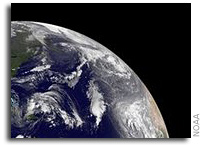NSF-TERC-NASA & Challenger Center Earth Science Challenge Seeks Volunteers

When Richard Garriott is in space, he plans to take photographs of the Earth, many of which will replicate some of the photographs his father, astronaut Dr. Owen Garriott took 35 years ago on Skylab. Looking at astronaut photography over time, we can see changes that have happened on Earth over the last generation. We can use this information to see how humans have impacted different regions on the planet over time and to make predictions about what may occur in the future.
The NSF-TERC-NASA & Challenger Center Earth Science Challenge for Richard Garriott’s mission currently needs some volunteers to create a 3D Animation. It would be nice to have it in Flash or Shockwave.
If you are interested in donating your time and effort – or know someone who might – please contact Muhammad Shazlee at 703-683-9740 x 1354 or by email at tshazlee@challenger.org
Activity #1: How do we track the space station’s location? Estimated date of completion: October 31, 2008 or before. Classroom Lesson Understanding the orbit of the ISS using a globe and by building a flat map of the orbital track.
-This will be a hands-on activity for teachers to use with grades 5-12.
-There will be teacher instructions, linked resources and a student worksheet.
-Teachers will provide a demonstration using visual cues (globe, imagery) and students will do mathematical calculations to visualize the altitude of the ISS orbit.
-Students will then complete a hands-on lab activity that helps them to describe the orbital track (path) and direction of travel. Multimedia Resource Students will view a 3D animation that illustrates the rotation of the earth, the orbit of the ISS and the orbital track on a flat map.
-These will be new animation created in partnership with a group of student programmers, or a compilation of available NASA animations to be used as supplementary resources to Activity #1.








